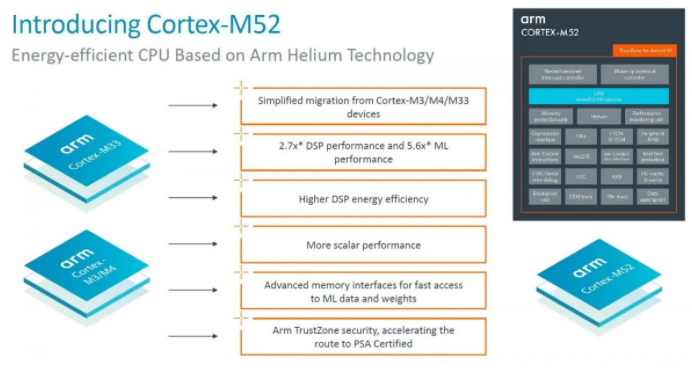Since the rise of AI with ChatGPT, AI chips have seen unprecedented development. At the end of October, Qualcomm released the Snapdragon X Elite chip with AI capabilities based on the Arm architecture. Recently, Arm announced the upcoming launch of the Cortex-M52 chip in 2024, which will bring AI acceleration features to low-power IoT devices. According to Arm, the Arm Cortex-M52 is designed as the smallest and most cost-effective processor for AI acceleration applications. This chip is expected to provide “enhanced” AI capabilities for IoT devices without the need for a separate computing unit.The Cortex-M52, previously known as “Star-MC2” in the Chinese market, is a collaborative product developed by Arm and the engineering team at SiFive.The design of the Cortex-M52 chip incorporates Arm’s Helium technology, adding 150 new scalar and vector instructions to the Armv8.1-M Cortex-M series (including Cortex-M55 and Cortex-M85). Compared to the previous generation Cortex-M, Helium instructions can improve the performance of machine learning algorithms by 5.6 times and enhance the performance of digital signal processing (DSP) workloads by 2.7 times.Paul Williamson, Arm’s Senior Vice President and General Manager of IoT Business, emphasized that to fully leverage the potential of AI in the IoT space, machine learning optimization must be introduced into the “smallest, lowest power” endpoint devices. Williamson pointed out that although AI is ubiquitous, extracting “intelligence” from the vast amounts of data flowing through digital devices requires smarter and more powerful IoT devices.Emphasizing SecuritySecurity remains a critical aspect.The Cortex-M52 implements the latest security extensions of the Armv8.1-M architecture, including Pointer Authentication and Branch Target Identification (PACBTI) and Arm TrustZone technology.Arm stated that the Cortex-M52 also aids in accelerating the rollout of PSA Certified Level 2 certified chips, thereby enabling the next generation of PSA Certified devices.Cost SavingsAdditionally, the Cortex-M52 provides a simplified migration path from Cortex-M33 and Cortex-M4, catering to various AIoT application needs, such as automotive and industrial control, predictive maintenance, and wearable sensor fusion.Thanks to this, the Cortex-M52 can offer scalable flexibility across a range of performance points and configurations while providing DSP capabilities without the need for a separate processing unit, thus saving chip area and costs.Development Requires Only One ToolchainThe new chip design also promotes a “modernized development process,” allowing developers to access a unified toolchain for the Cortex-M platform, fully supporting AI workflows.Before the Cortex-M52, developers had to combine CPU, DSP, and NPU units with three different software toolkits to achieve the ML and DSP performance natively provided by new designs.Arm stated that now only one toolchain is sufficient. The Cortex-M52 is fully compatible with software written for the Cortex-M55 and Cortex-M85, and the new chip will also facilitate pre-silicon software development through the Arm Virtual Hardware Cloud Platform.Williamson noted that the Cortex-M52 technology can be licensed for integration into very low-cost IoT products, with chips costing between $1-2 potentially making up a large portion of production volume. He added that this chip can also be integrated into “slightly more feature-rich” IoT devices.
According to Arm, the Arm Cortex-M52 is designed as the smallest and most cost-effective processor for AI acceleration applications. This chip is expected to provide “enhanced” AI capabilities for IoT devices without the need for a separate computing unit.The Cortex-M52, previously known as “Star-MC2” in the Chinese market, is a collaborative product developed by Arm and the engineering team at SiFive.The design of the Cortex-M52 chip incorporates Arm’s Helium technology, adding 150 new scalar and vector instructions to the Armv8.1-M Cortex-M series (including Cortex-M55 and Cortex-M85). Compared to the previous generation Cortex-M, Helium instructions can improve the performance of machine learning algorithms by 5.6 times and enhance the performance of digital signal processing (DSP) workloads by 2.7 times.Paul Williamson, Arm’s Senior Vice President and General Manager of IoT Business, emphasized that to fully leverage the potential of AI in the IoT space, machine learning optimization must be introduced into the “smallest, lowest power” endpoint devices. Williamson pointed out that although AI is ubiquitous, extracting “intelligence” from the vast amounts of data flowing through digital devices requires smarter and more powerful IoT devices.Emphasizing SecuritySecurity remains a critical aspect.The Cortex-M52 implements the latest security extensions of the Armv8.1-M architecture, including Pointer Authentication and Branch Target Identification (PACBTI) and Arm TrustZone technology.Arm stated that the Cortex-M52 also aids in accelerating the rollout of PSA Certified Level 2 certified chips, thereby enabling the next generation of PSA Certified devices.Cost SavingsAdditionally, the Cortex-M52 provides a simplified migration path from Cortex-M33 and Cortex-M4, catering to various AIoT application needs, such as automotive and industrial control, predictive maintenance, and wearable sensor fusion.Thanks to this, the Cortex-M52 can offer scalable flexibility across a range of performance points and configurations while providing DSP capabilities without the need for a separate processing unit, thus saving chip area and costs.Development Requires Only One ToolchainThe new chip design also promotes a “modernized development process,” allowing developers to access a unified toolchain for the Cortex-M platform, fully supporting AI workflows.Before the Cortex-M52, developers had to combine CPU, DSP, and NPU units with three different software toolkits to achieve the ML and DSP performance natively provided by new designs.Arm stated that now only one toolchain is sufficient. The Cortex-M52 is fully compatible with software written for the Cortex-M55 and Cortex-M85, and the new chip will also facilitate pre-silicon software development through the Arm Virtual Hardware Cloud Platform.Williamson noted that the Cortex-M52 technology can be licensed for integration into very low-cost IoT products, with chips costing between $1-2 potentially making up a large portion of production volume. He added that this chip can also be integrated into “slightly more feature-rich” IoT devices.